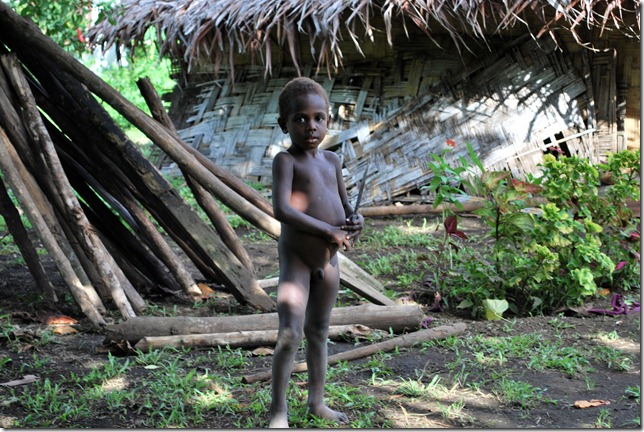We left Lamen Bay with Anima at about 6am and sailed for the nearby island of Malakula. Malakula is one of the larger islands in Vanuatu, but isn’t too heavily populated and doesn’t have a large, modern city. In the past, the residents of the island were grouped in the large nambas and small nambas, according to the size of the namba they wore, with the large nambas living in the northern part of the island and the small nambas living in the south. The namba is the traditional male garment on Malakula. You probably haven’t seen one at the Gap, unless they’ve added a “penis sheath made from a large leaf” section since we’ve left.
We raced Anima to Banam Bay (we won, so it was an official race) and caught a yellow-fin tuna on the way that was gone within minutes of dropping the anchor in the large, tranquil bay. The cruising guide said to take the dinghy in toward a large tree in the middle of the white sandy beach, which must have been a joke as the boat was surrounded on two sides by a long, white, sandy beach more than a mile long with no particularly noteworthy trees. The guide also said that a nice traditional dance could be arranged with the chief for $15 each, and it was already afternoon so we hurried in to the beach near some out-of-place looking buoys.
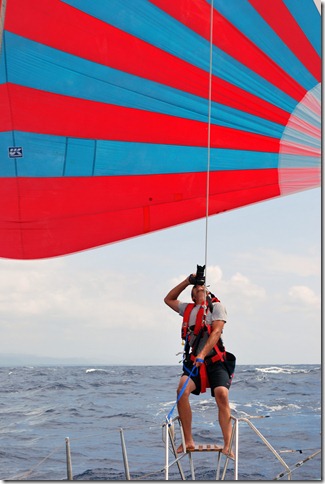 Colin got some interesting shots on the passage to Banam Bay
Colin got some interesting shots on the passage to Banam Bay
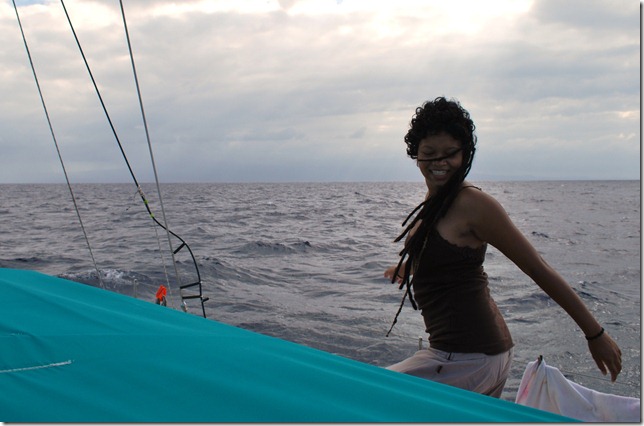 Shiroma’s music inspired the girls to dance
Shiroma’s music inspired the girls to dance
We were met at the beach by Jake, who spoke pretty good English and showed us the “yacht club” they had started building several years earlier. It was a nice little structure with a conical roof, a couple of benches and a bar/kitchen area, but it had never been utilized. Jake was in charge of the “yacht club” and was the apparent Banam Bay ambassador to yachties. He assured Martin that he could watch the night’s World Cup games at a school about an hour’s walk away and then took us to meet the chief to arrange for the dancing. He had us stop at the edge of the village and wait for Chief Saro. Nearly everyone was living in thatched-roof huts with woven bamboo walls and they were pretty curious to see us, especially the children. Jake later told us we were the first yachts of the year to stop in Banam Bay. Jake told us the chief was 98 years old, and as he swayed out of his hut and his steps meandered weakly back and forth on his walk toward us, I was afraid that we might be the last yachties he saw. He must have been napping, because he seemed to get stronger as he walked toward us and by the time he reached us he was chiefly presence. He shook hands with all of us, welcomed us to his village and Banam Bay, and we introduced ourselves and told him we were interested in the custom dancing. He then exchanged a few words with Jake who told us that the dance would be at 3:30 the next day followed by a lap-lap (food for us involving chicken and coconut).
We all said goodbye to the chief and then Jake led us down the road through the village. The children were absolutely taken with Lauren and her camera and she and Shiroma spent much of the time surrounded. Shiroma’s long dreadlocks were fascinating to them as well, and she said at one point a different child was holding onto each dreadlock. Jake and I had a nice talk while we walked. He’s been working with an American medical project to bring occasional medical care to the villages. The village seemed fairly primitive and without electricity. Nobody in the village owned a truck, although Jake said trucks and the track through the forest had first appeared about 25 years ago. Cell phone coverage had just arrived in the village last year and there were already two competing providers. Being a relatively young democracy with little in the way of mass communications to the more remote areas, politicians and political workers travel through the countryside the month before the elections telling people about the candidates and then the villagers go to the local school to vote. Although Bislama is the national language and the only one that allows all ni-Vanuatu people to communicate, Jake and numerous others spoke pretty good English.
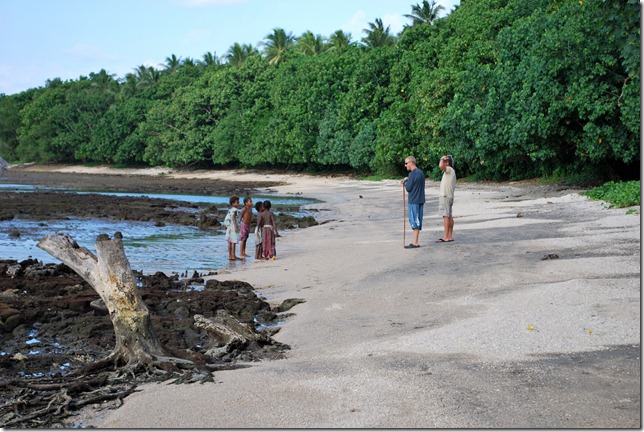 Checking out the tall white men from a distance
Checking out the tall white men from a distance
Near the end of the village we arrived at Jake’s house and met his wife Lucy, two young boys, and several friends. Jake has three huts – one for living in, one for cooking, and a third that perhaps is an older house but is now mostly empty. He’d asked me what I did for work in the states and I’d told him that I’d done some electrical engineering. When we got to his house he showed me a solar panel, battery, regulator, and inverter that had never worked and wondered if I could do something to fix them. It was all novel technology to him, but he knew what they were capable of and really was anxious to have electricity. He’d had the solar panel for several years but never gotten it to do anything.
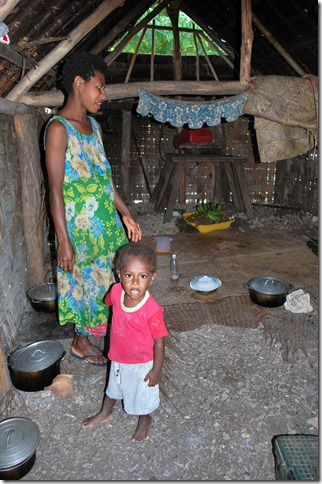 Lucy showing us her cooking hut
Lucy showing us her cooking hut
The next morning, after watching the World Cup all night, Martin dropped Jake off at our boat. We ate breakfast and I collected some tools and a spare engine starting battery that I’d been keeping for some reason even though it was too weak to turn the engines. Colin joined us we dinghied across the bay to Jake’s house, with Jake and I carrying the battery down the beach and into the dark hut. After a bit of troubleshooting, I was able to determine that the solar panel was in good condition and working fine and the regulator worked once a broken input wire was repaired and several bad connections were cleaned and renewed. His battery was toast after sitting unused for over year, but my old one worked just fine and after fiddling with connections we were able to power-up the American inverter that someone had left him. I’ll never forget the look of joy on his face when he plugged in his cell phone charger and the phone lit up with the charging symbol. It was a project that had apparently been years in the making. I explained a few basics about how to get the most from the solar panel and how to repair the wiring and left a cheap spare voltmeter. He said that he would like to have a light in his home at night, so I walked off the distance from the hut with the battery to his living house and told him that after the dancing I would come back and rig up some lighting. He was pretty pleased and said he’d arrange to have kava for us all in his home after the dance.
Colin and I sped back to the boat where I worked to string together 70 feet of wire from three different spare sections I had on board. I also took a 12V LED strip-light that I’d gotten as a gift from S/V Imagine and broke it into two separate lights, soldered on lead wires, and taped it into the original clear packaging to make two bright, power-efficient, and somewhat rain-proof lights. Then it was time for a short nap before the afternoon’s activities.


